An Assessment of the Performance of the PLUS+ Tool in Supporting the Evaluation of Water Framework Directive Compliance in Scottish Standing Waters
Abstract
1. Introduction
- (a)
- Evaluation of the current TP status of standing waters in Scotland
- (b)
- Description of the PLUS+ tool and its preliminary application to 323 monitored catchments, and 7471 unmonitored catchments.
- (c)
- Evaluation of PLUS+ performance compared to observed data
- (d)
- Assessment of the importance of TP in terms of non-compliance with the WFD
- (e)
- Sensitivity analysis
- (f)
- Evaluation of the effectiveness of the tool when applied to selected catchments that receive TP predominantly from sources other than the land runoff.
2. Materials and Methods
2.1. Study Area
2.2. Description of PLUS+
2.3. Sources of P included in PLUS+
2.3.1. Land Cover
2.3.2. Waste Water Treatment Works and Septic Tanks
2.3.3. Other Sources of Phosphorus
2.4. Input Data to PLUS+
- (a)
- Mean annual TP concentrations for 2014 from SEPA’s routine monitoring campaign of standing waters. This data has 334 records, however, eight records have a TP concentration of zero (and zero confidence), and three more have a waterbody ID that is not in the PLUS+ database, leaving 323 waterbodies with measured TP concentrations.
- (b)
- Meteorological Office 5-km climate grids from 2010 were used to generate discharge (to calculate TP loads) and using a water balance model [28,29]. Meanwhile, potential evapotranspiration was estimated using the FAO56 modified Penman–Monteith methodology [30]. The water balance model also includes soils information from Hydrology of Soil Types (HOST) classes [31].
- (c)
- Land cover and associated TP exports as described in Section 2.3.1.
- (d)
- Specific data on bird numbers (case study sites only).
- (e)
- TP breakpoint data with TP concentration thresholds corresponding to the WFD status, supplied by SEPA.
- (f)
- Sub-catchment boundaries corresponding to the standing waters in the model. There are 8030 standing waters for which PLUS+ will calculate the TP. However, it is not possible to assess 236 of these standing waters against WFD status as they are not included in the TP breakpoint data. This means that there is a total of 7471 unmonitored waterbodies in PLUS+ which may be assessed against WFD status.
2.5. Phosphorus Load and Concentrations
2.6. Sensitivity Testing
2.6.1. Export Coefficients (EC)
2.6.2. Discharge
2.6.3. Land Cover
3. Results
3.1. Observed TP Concentrations in Scottish Standing Waters
3.2. Validation of PLUS+ TP Concentrations against Measured Data
3.3. National Assessment of Compliance with the Water Framework Directive
3.3.1. Total Phosphorus Status of all Standing Waters in Scotland
3.3.2. Compliance/Non-Compliance with the WFD Based on Modelled and Measured TP Concentrations
3.3.3. Comparison of Modelled and Measured WFD Class at 323 Surface Waters
3.4. Case Studies
4. Discussion
5. Conclusions
- A national comprehensive and spatially explicit dataset of annual TP export from WWTWs should be included, with an indication of which standing waters they discharge effluent to (i.e., some WWTWs discharge effluent to standing waters in another catchment).
- The P losses from septic tanks to water need to be updated to reflect recent findings which concluded that discharges to water from these systems could be as high as 0.6 kg P/yr (per septic tank) [57].
- When spatial data of the locations of septic tanks is published, it should be included.
- The land cover map described in this study represents a collection of the best available spatial data for Scotland; however, it needs to be updated when more recent data become available, such as the more recently published Land Cover Map 2015 (LCM2015; https://www.ceh.ac.uk/services/land-cover-map-2015) and the next Countryside Survey for the UK.
- A national database of freshwater fish farm operations and their P exports to freshwaters needs to be developed and added to the PLUS+ tool
- The export coefficients within PLUS+, and their associated land cover classes need to be reviewed within an uncertainty framework.
- Given that TP concentrations seem to be relatively insensitive to changes in discharge, a review of the hydrological routine in PLUS+ needs to be undertaken to assess the effect of climate /land use change on compliance with EU Directives.
- The validation dataset needs to be expanded to cover a wider number of years, because SEPA measurements for 2014 only are considered here.
Supplementary Materials
Author Contributions
Funding
Acknowledgments
Conflicts of Interest
References
- Lin, P.; Klump, J.V.; Guo, L. Dynamics of Dissolved and Particulate Phosphorus influenced by Seasonal Hypoxia in Green Bay, Lake Michigan. Sci. Total Environ. 2016, 541, 1070–1082. [Google Scholar] [CrossRef] [PubMed]
- Wang, J.; Chen, J.; Ding, S.; Guo, J.; Christopher, D.; Dai, Z.; Yang, H. Effects of Seasonal Hypoxia on the Release of Phosphorus from Sediments in Deep-water Ecosystem: A case study in Hongfeng Reservoir, Southwest China. Environ. Pollut. 2016, 219, 858–865. [Google Scholar] [CrossRef] [PubMed]
- Jennings, E.; Allott, N.; Lenihan, D.; Quirke, B.; Taylor, D.; Twomey, H. Drivers of long-term trends and seasonal changes in total phosphorus loads to a Mesotrophic Lake in the west of Ireland. Mar. Freshw. Res. 2013, 64, 413–422. [Google Scholar] [CrossRef]
- Jeppesen, E.; Sondergaard, M.; Jensen, J.P.; Havens, K.E.; Anneville, O.; Carvalho, L.; Coveney, M.F.; Deneke, R.; Dokulil, M.T.; Foy, B.; et al. Lake responses to reduced nutrient loading – an analysis of contemporary long-term data from 35 case studies. Freshw. Biol. 2005, 50, 1747–1771. [Google Scholar] [CrossRef]
- Schindler, D.W. Recent advances in the understanding and management of eutrophication. Limnol. Oceanogr. 2006, 51, 356–363. [Google Scholar] [CrossRef]
- Søndergaard, M.; Jeppesen, E.; Lauridsen, T.L.; Skov, C.; Van Nes, E.H.; Roijackers, R.R.; Lammens, E.; Portielje, R. Lake restoration: Successes, failures and long-term effects. J. Appl. Ecol. 2007, 44, 1095–1105. [Google Scholar] [CrossRef]
- Vaccari, D.A. Phosphorus: A looming crisis. Sci Am. 2009, 300, 54–59. [Google Scholar] [CrossRef]
- Naden, P.; Bell, V.; Carnell, E.; Tomlinson, S.; Dragosits, U.; Chaplow, J.; May, L.; Tipping, E. Nutrient fluxes from domestic wastewater: A national-scale historical perspective for the UK 1800–2010. Sci. Total Environ. 2016, 572, 1471–1484. [Google Scholar] [CrossRef]
- Jia, B.; Tang, Y.; Tian, L.; Franz, L.; Alewell, C.; Huang, J. Impact of Fish Farming on Phosphorus in Reservoir Sediments. Sci. Rep. 2015, 5, 16617. [Google Scholar] [CrossRef]
- Sobota, D.J.; Harrison, J.A.; Dahlgren, R.A. Linking dissolved and particulate phosphorus export in rivers draining California’s Central Valley with anthropogenic sources at the regional scale. J. Environ. Qual. 2011, 40, 1290–1302. [Google Scholar] [CrossRef]
- May, L.; Place, C.J.; George, D.G. Estimation of the phosphorus load to surface waters from septic tanks in rural catchments. In Diffuse Pollution and Agriculture II, Proceedings of a Conference Held in Edinburgh, Edinburgh, UK, 9–11 April 1997; Petchey, A.M., D’Arcy, B.J., Frost, C.A., Eds.; SAC: Aberdeen, UK, 1998; pp. 212–216. [Google Scholar]
- Manny, B.A.; Johnson, W.C.; Wetzel, R.G. Nutrient Additions by Waterfowl to Lakes and Reservoirs: Predicting their effects on Productivity and Water Quality. Hydrobiology 1994, 279, 121–132. [Google Scholar] [CrossRef]
- UKTAG. Guidance on the Identification of Small Surface Water Bodies; Report of the UK Technical Advisory Group on the Water Framework Directive; UKTAG: Edinburgh, UK, 2015; p. 13. [Google Scholar]
- Directive 2000/60/EC of the European Parliament and of the Council of October 23rd, 2000 Establishing a Framework for Community Action in the Field of Water Policy. Off. J. Eur. Communities 2000, 12, 2000.
- Jackson-Blake, L.A.; Wade, A.J.; Futter, M.N.; Butterfield, D.; Couture, R.M.; Cox, B.A.; Crossman, J.; Ekholm, P.; Halliday, S.J.; Jin, L.; et al. The Integrated Catchment model of phosphorus dynamics (INCA-P): Description and demonstration of new model structure and equations. Environ. Model Softw. 2016, 83, 356–386. [Google Scholar] [CrossRef]
- UKTAG. Lake Assessment Method. Lake Phosphorus Standards; Water Framework Directive; United Kingdom Technical Advisory Group (WFD-UKTAG): Edinburgh, UK, 2016. [Google Scholar]
- Johnes, P.J. Evaluation and management of the impact of land use change on the nitrogen and phosphorus load delivered to surface waters: The export coefficient modelling approach. J. Hydrol. 1996, 183, 323–349. [Google Scholar] [CrossRef]
- Greene, S.; Johnes, P.J.; Bloomfield, J.P.; Reaney, S.M.; Lawley, R.; Elkhatib, Y.; Freer, J.; Odoni, N.; Macleod, C.J.A.; Percy, B. A geospatial framework to support integrated biogeochemical modelling in the United Kingdom. Environ. Model. Softw. 2015, 68, 219–232. [Google Scholar] [CrossRef]
- Johnes, P.J.; Foy, R.; Butterfield, D.; Haygarth, P.M. Land use scenarios for England and Wales: Evaluation of management options to support ‘good ecological status’ in surface freshwaters. Soil Manag. 2007, 23, 176–194. [Google Scholar]
- Ding, X.; Shen, Z.; Hong, Q.; Yang, Z.; Wu, X.; Liu, R. Development and test of the export coefficient model in the upper reach of the Yangtze River. J. Hydrol. 2010, 383, 233–244. [Google Scholar] [CrossRef]
- Brooker, N.; Marsden, M.; Richman, A.; Malcolm, A. The Development of a GIS Based Tool for Calculating the Total Phosphorus Load from a Catchment. Contract Report for Collaborative Project between The Macaulay Land Use Research Institute and The Forth River Purification Board. 1995. Available online: www.hutton.ac.uk/sites/default/files/files/waters/Downloads/PLUS_1995.pdf (accessed on 6 January 2020).
- Donnelly, D.; Booth, P.; Ferrier, R.C.; Stutter, M. Phosphorus Land Use and Slope (PLUS+) Model User Guide & Computer Code; Internal Report Produced on Behalf of the Scottish Environment Protection Agency and the James Hutton Institute; Scottish Environment Protection Agency and The James Hutton Institute: Dundee, UK, 2011; Available online: http://www.hutton.ac.uk/sites/default/files/files/Plus+%20User%20Guide%20-%20v1_6.pdf (accessed on 20 December 2019).
- Donnelly, D. Phosphorus Land Use and Slope (PLUS+) Model (Data) & Computer Code. Git Repository. 2019. Available online: https://github.com/DavidHutton/plus (accessed on 20 December 2019).
- Land Cover of Scotland 1988 (LCS88). Available online: https://www.hutton.ac.uk/learning/exploringscotland/landcover-scotland (accessed on 20 December 2019).
- Land Use/Land Cover Data-LCM. Available online: https://www.ceh.ac.uk/services/land-cover-map-2007 (accessed on 20 December 2017).
- Data.Gov.UK. 2011. Available online: https://data.gov.uk/dataset/data-zone-boundaries (accessed on 20 December 2019).
- Scotland’s Aquaculture. Available online: http://aquaculture.scotland.gov.uk/ (accessed on 20 December 2019).
- Dunn, S.M.; Vinten, A.J.A.; Lilly, A.; DeGroote, J.; McGechan, M. Nitrogen risk assessment model for Scotland: I. Nitrogen leaching. Hydrol. Earth Syst. Sci. 2004, 8, 191–204. [Google Scholar] [CrossRef]
- Sample, J.; Dunn, S.M. Spatially Distributed Modelling in Support of the 2013 Review of the Nitrates Directive. CD2014_02. 2014. Available online: http://www.crew.ac.uk/publications (accessed on 7 January 2020).
- Allen, R.G.; Pereira, L.S.; Raes, D.; Smith, M. Crop Evapotranspiration—Guidelines for Computing Crop Water Requirements; FAO: Rome, Italy, 1998. [Google Scholar]
- Boorman, D.B.; Hollis, J.M.; Lilly, A. Hydrology of Soil Types: A Hydrologically Based Classification of the Soils of United Kingdom; IH Report No. 126; Institute of Hydrology: Wallingford, UK, 1995; p. 146. [Google Scholar]
- Organisation for Economic Co-Operation and Development (OECD). Eutrophication of Waters, Monitoring Assessment and Control; OECD: Paris, France, 1982. [Google Scholar]
- Stevens, C.; Richard, P.; Adam, K. How will the semi-natural vegetation of the UK have changed by 2030 given likely changes in nitrogen deposition? Environ. Pol. 2016, 208, 879–889. [Google Scholar] [CrossRef]
- SNIFFER. Provision of a Screening Tool to Identify and Characterise Diffuse Pollution Pressures: Phase II. Project WFD19 (230/8050). 2006. Available online: http://www.sniffer.org.uk/files/4313/4183/7424/WFD19.pdf (accessed on 20 December 2019).
- Artz, R.R.E.; Donnelly, D.; Andersen, R.; Mitchell, R.; Chapman, S.J.; Smith, J.; Smith, P.; Cummins, R.; Balana, B.; Cuthbert, A. Managing and Restoring Blanket Bog to Benefit Biodiversity and Carbon Balance—A Scoping Study; Scottish Natural Heritage Commissioned Report No. 562; Scottish Natural Heritage: Inverness, UK, 2014. [Google Scholar]
- Artz, R.R.E.; Faccioli, M.; Roberts, M.; Anderson, R. Peatland Restoration—A Comparative Analysis of the Costs and Merits of Different Restoration Methods. CXC Report. 2018. Available online: https://www.climatexchange.org.uk/media/3141/peatland-restoration-methods-a-comparative-analysis.pdf (accessed on 20 December 2019).
- Lindsay, R.; Bernie, R.; Clough, J. IUCN UK Committee Peatland Programme Briefing Note Complete Set 1–10; University of East London: London, UK, 2014; Available online: http://www.iucnukpeatlandprogramme.org/sites/www.iucn-uk-peatlandprogramme.org/files/1-10%20Peatland%20Briefings%20-%205th%20November%202014.pdf (accessed on 20 December 2019).
- Muller, D.K.; Helsel, D.R. Nutrients in the Nation’s Water—Too Much of Good Thing? Circular 1136; U.S. Geological Survey: Denver, CO, USA; OECD: Paris, France, 1996.
- Carvalho, L.; Bennion, H.; Darwell, A.; Gunn, I.; Lyle, A.; Monteith, D.; Wade, M. Physico-Chemical Conditions for Supporting Different Levels of Biological Quality for the Water Framework Directive for Freshwaters R&D Technical Report; Final Report to the Environment Agency: Edinburgh, UK, 2002.
- Tipping, E.; Benham, S.; Boyle, J.F.; Crow, P.; Davies, J.; Fischer, U.; Guyatt, H.; Helliwell, R.; Jackson-Blake, L.; Lawlor, A.J.; et al. Atmospheric deposition of phosphorus to land and freshwater. Environ. Sci. Process. Impacts 2014, 16, 1608–1617. [Google Scholar] [CrossRef]
- Hearn, R. The 2002 Icelandic Breeding Goose Census; Wildfowl and Wetland Trust Report; The Wildfowl & Wetlands Trust: Slimbridge, UK, 2004. [Google Scholar]
- Anthony, S.; Duethmann, D.; Turner, T.; Carvalho, L.; Spears, B. Identifying the Gap to Meet the Water Framework Directive; Lakes Baseline Defra Project WT0750CSF, Final Report; ADAS UK Ltd.: Defra, UK, 2008; p. 59. [Google Scholar]
- Marsden, M.W.; Fozzard, I.R.; Clark, D.; McLean, N.M.; Smith, M.R. Control of Phosphorus Inputs to a Freshwater Lake. A Case Study. Aquac. Res. 1995, 26, 527–538. [Google Scholar] [CrossRef]
- Fozzard, I.; Doughty, R.; Ferrier, R.C.; Leatherland, T.; Owen, R. A quality classification for management of Scottish standing waters. Hydrobiology 1999, 395, 433–453. [Google Scholar] [CrossRef]
- Scotland’s Places. Available online: http://www.scotlandsplaces.gov.uk/record/rcahms/65047/milton-loch/rcahms?inline=true (accessed on 20 December 2019).
- Spears, B.; Carvalho, L.; Paterson, D. Phosphorus partitioning in a shallow lake: Implications for water quality management. Water Environ. J. 2007, 21, 47–53. [Google Scholar] [CrossRef]
- Heathwaite, A.L.; Dils, R.M.; Liu, S.; Carvalho, L.; Brazier, R.E.; Pope, L.; Hughes, M.; Phillips, G.; May, L. A tiered risk-based approach for predicting diffuse and point source phosphorus losses in agricultural areas. Sci. Total Environ. 2005, 344, 225–239. [Google Scholar] [CrossRef] [PubMed]
- Comber, S.D.W.; Smith, R.; Daldorph, P.W.G.; Gardner, M.J.; Constantino, C.; Ellor, B. Development of a Chemical Source Apportionment Decision Support Framework for Catchment Management. Environ. Sci. Technol. 2013, 47, 9824–9832. [Google Scholar] [CrossRef]
- Gooday, R.; Anthony, S.; Calrow, L.; Harris, D.; Skirvin, D. Predicting and Understanding the Effectiveness of Measures to Mitigate Rural Diffuse Pollution: Extract to Describe Pollutant Load Calculations, October 2016 SNIFFER Project DP1. 1–114. Available online: https://www.sniffer.org.uk/dp1-effect-of-measures-report-march-2016-pdf (accessed on 6 January 2020).
- Tipping, E.; Boyle, J.F.; Schillereff, D.N.; Spears, B.M.; Phillips, G. Macronutrient processing by temperate lakes: A dynamic model for long-term, large-scale application. Sci. Total Environ. 2016, 572, 1573–1585. [Google Scholar] [CrossRef]
- Davison, P.S.; Withers, P.J.A.; Lord, E.I.; Betson, M.J.; Strömqvist, J. PSYCHIC—A process-based model of phosphorus and sediment mobilisation and delivery within agricultural catchments. Part 1: Model description and parameterisation. J. Hydrol. 2018, 350, 290–302. [Google Scholar] [CrossRef]
- Collins, A.; Stromqvist, J.; Davison, P.; Lord, E. Appraisal of phosphorus and sediment transfer in three pilot areas identified for catchment sensitive farming initiative in England—Application of the prototype PSYCHIC model. Soil Manag. 2007, 23, 117–132. [Google Scholar] [CrossRef]
- Strömqvist, J.; Collins, A.L.; Davison, P.S.; Lord, E.I. PSYCHIC—A process-based model of phosphorus and sediment transfers within agricultural catchments. Part 2. A preliminary evaluation. J. Hydrol. 2008, 350, 303–316. [Google Scholar] [CrossRef]
- O’Keeffe, J.; Akunna, J.; Olszewska, J.; Bruce, A.; May, L. Practical Measures for Reducing Phosphorus and Faecal Microbial Loads from Onsite Wastewater Treatment System Discharges to the Environment: A Review; Scotland’s Centre of Expertise for Waters: Edinburgh, UK, 2015. [Google Scholar]
- Scottish Government. Scottish Fish Farm Production Survey (2016). Marine Scotland Science; Munro, L.A., Wallace, I.S., Eds.; Scottish Fish Farm Production Survey (2015). September 2016; Scottish Government: Edinburgh, UK, 2016; ISBN 9781786524270. Available online: http://www.gov.scot/Publications/2016/09/1480 (accessed on 20 December 2019).
- Holden, J.; Haygarth, P.M.; MacDonald, J.; Jenkins, A.; Sapiets, A.; Orr, H.G.; Dunn, N.; Harris, B.; Pearson, P.; McGonigle, D.; et al. Agriculture’s Impacts on Water Quality, Sub-Report. Farming and Water 1. 2015. Available online: http://www.foodsecurity.ac.uk/assets/pdfs/agriculture-water-quality-report.pdf (accessed on 20 December 2019).
- Richards, S.; Stutter, M.; Withers, P.J.A.; Paterson, E.; McRoberts, C.W. Potential tracers for tracking septic tank effluent discharges in watercourses. Environ. Pol. 2017, 228, 245–255. [Google Scholar] [CrossRef]

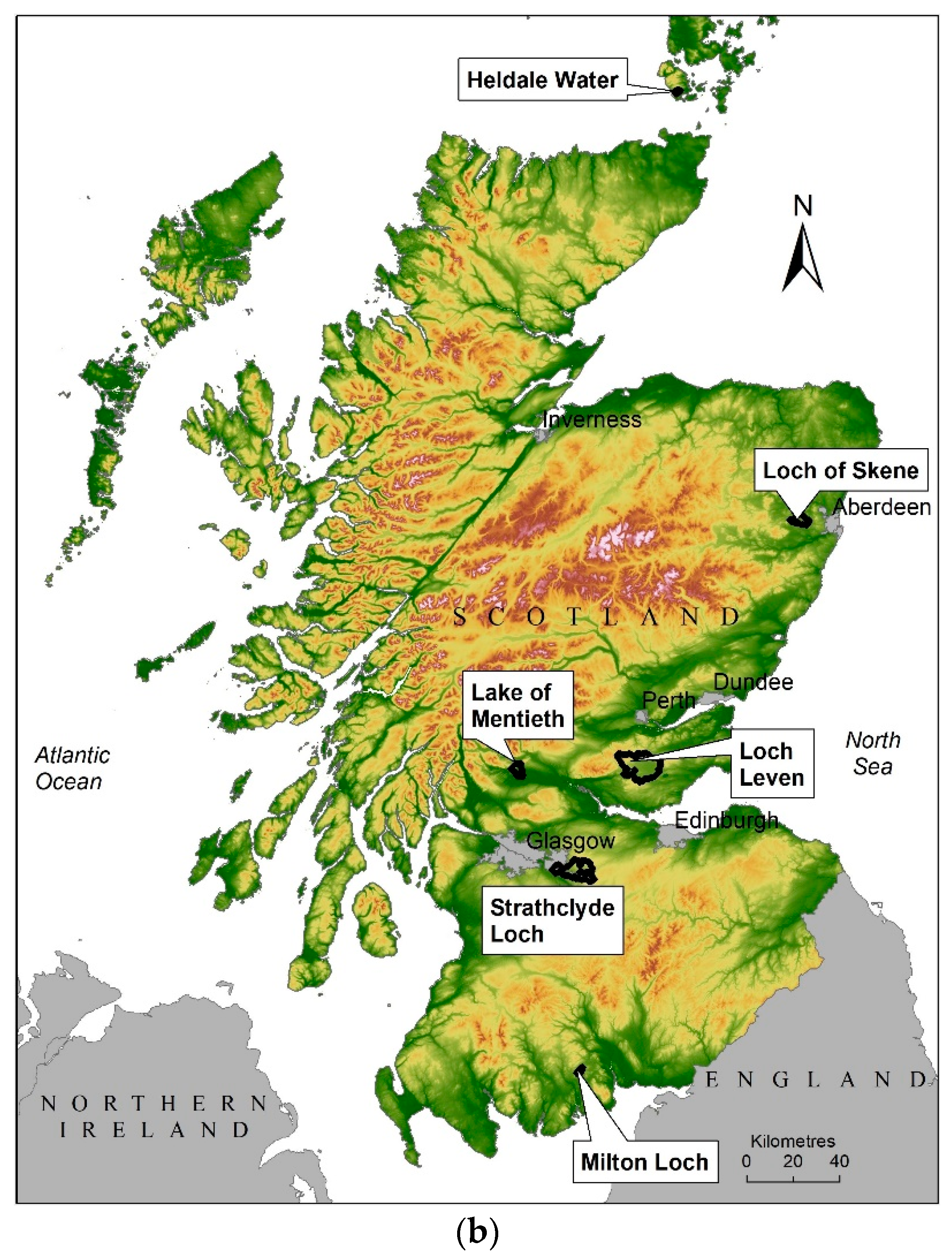
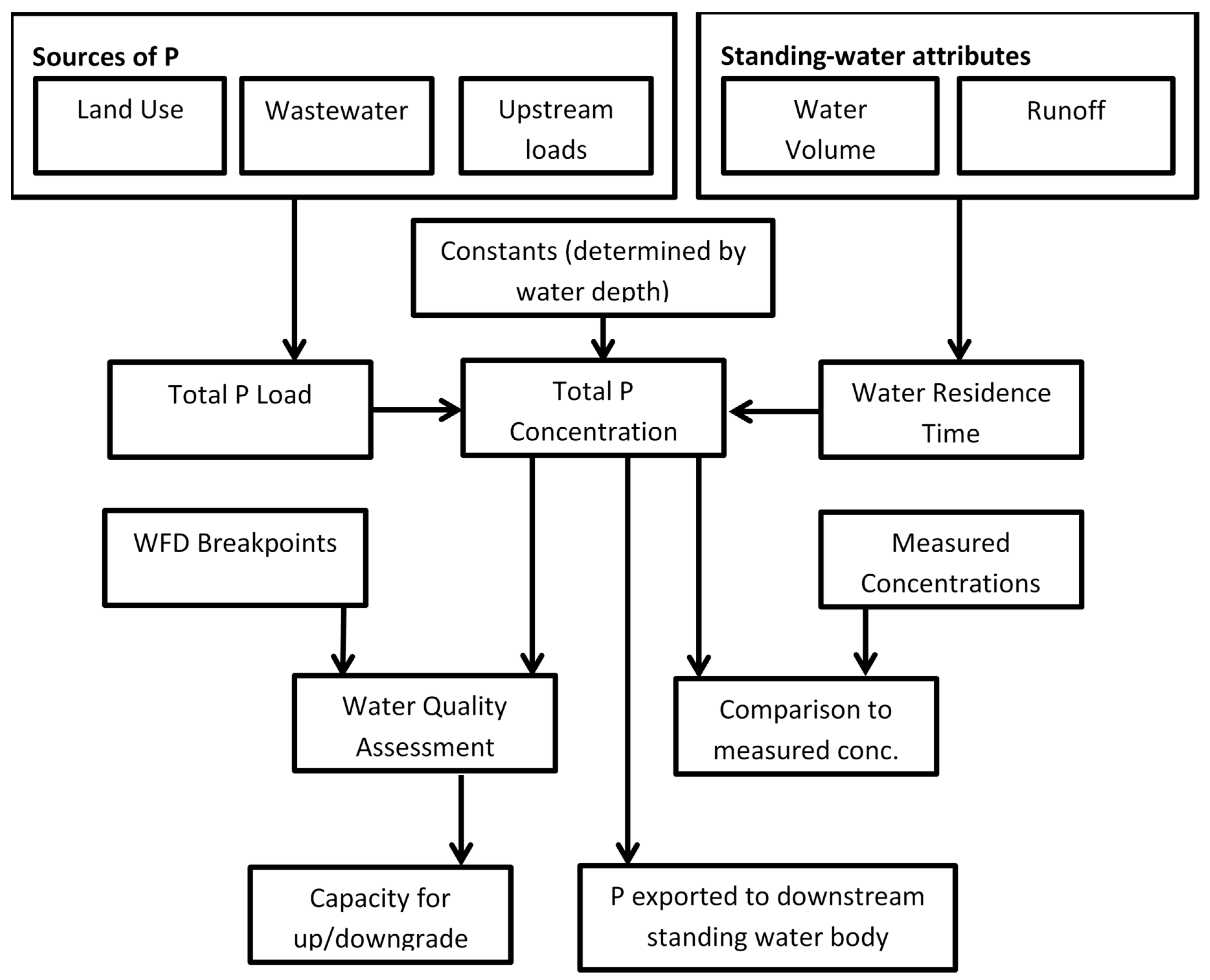
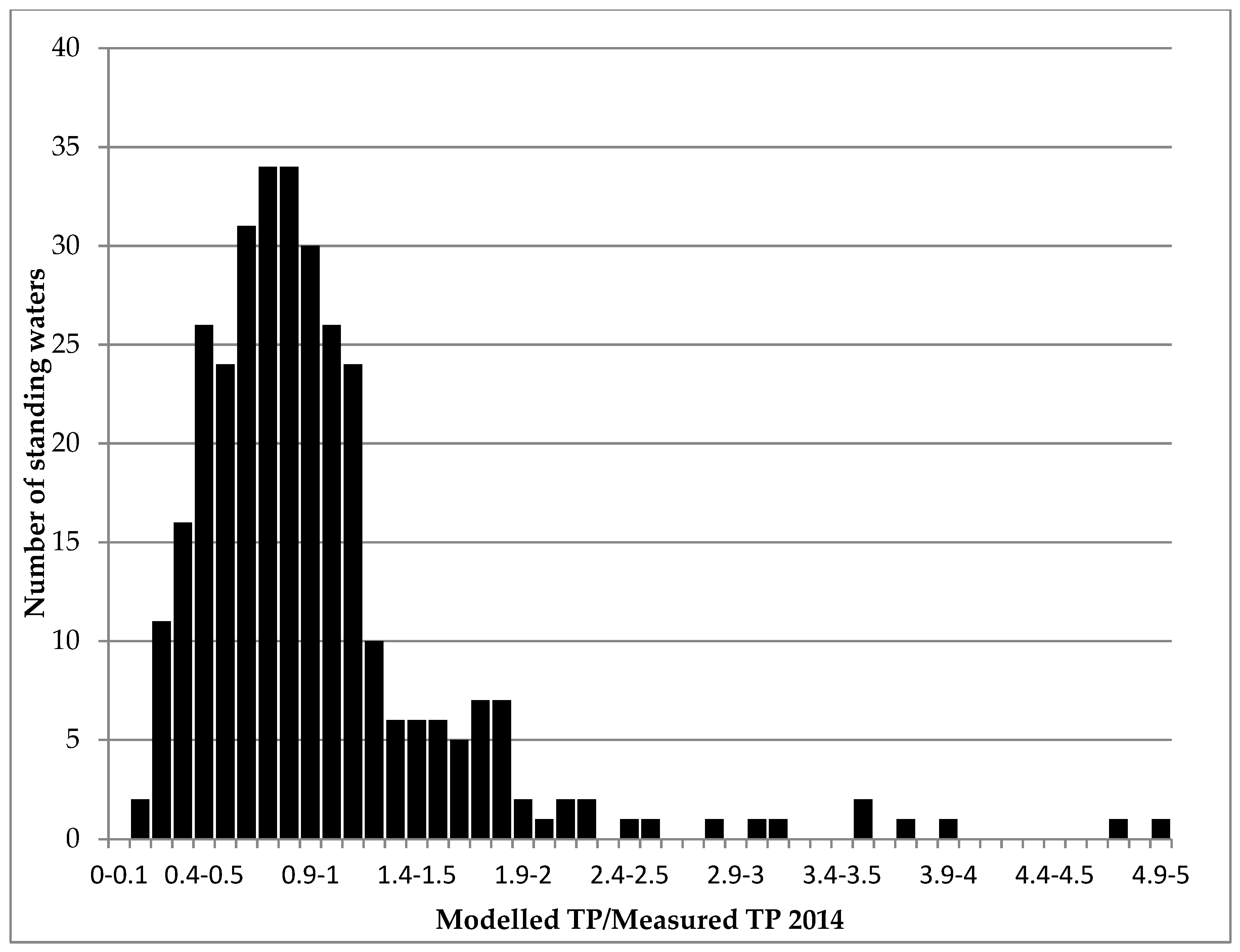

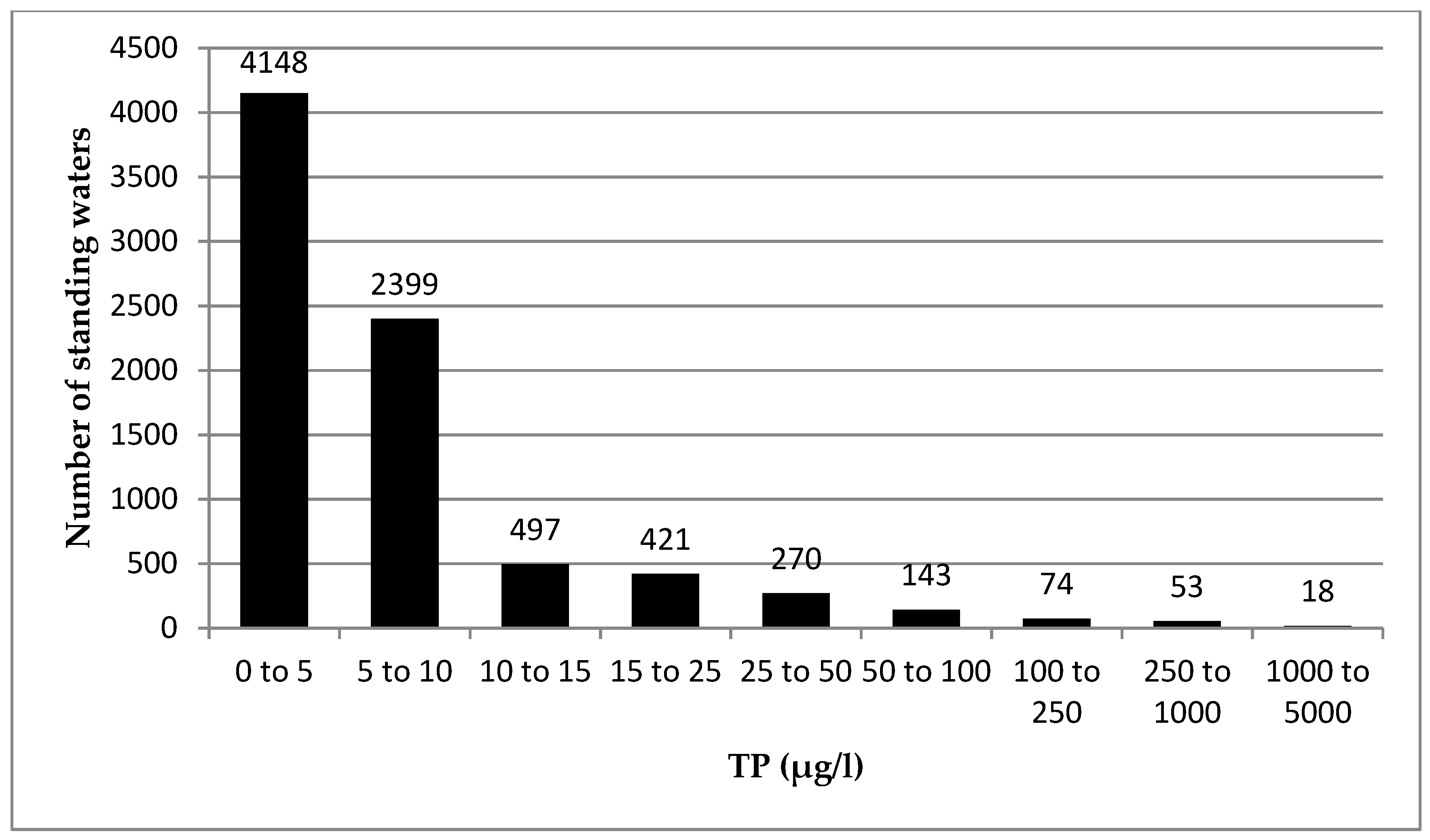
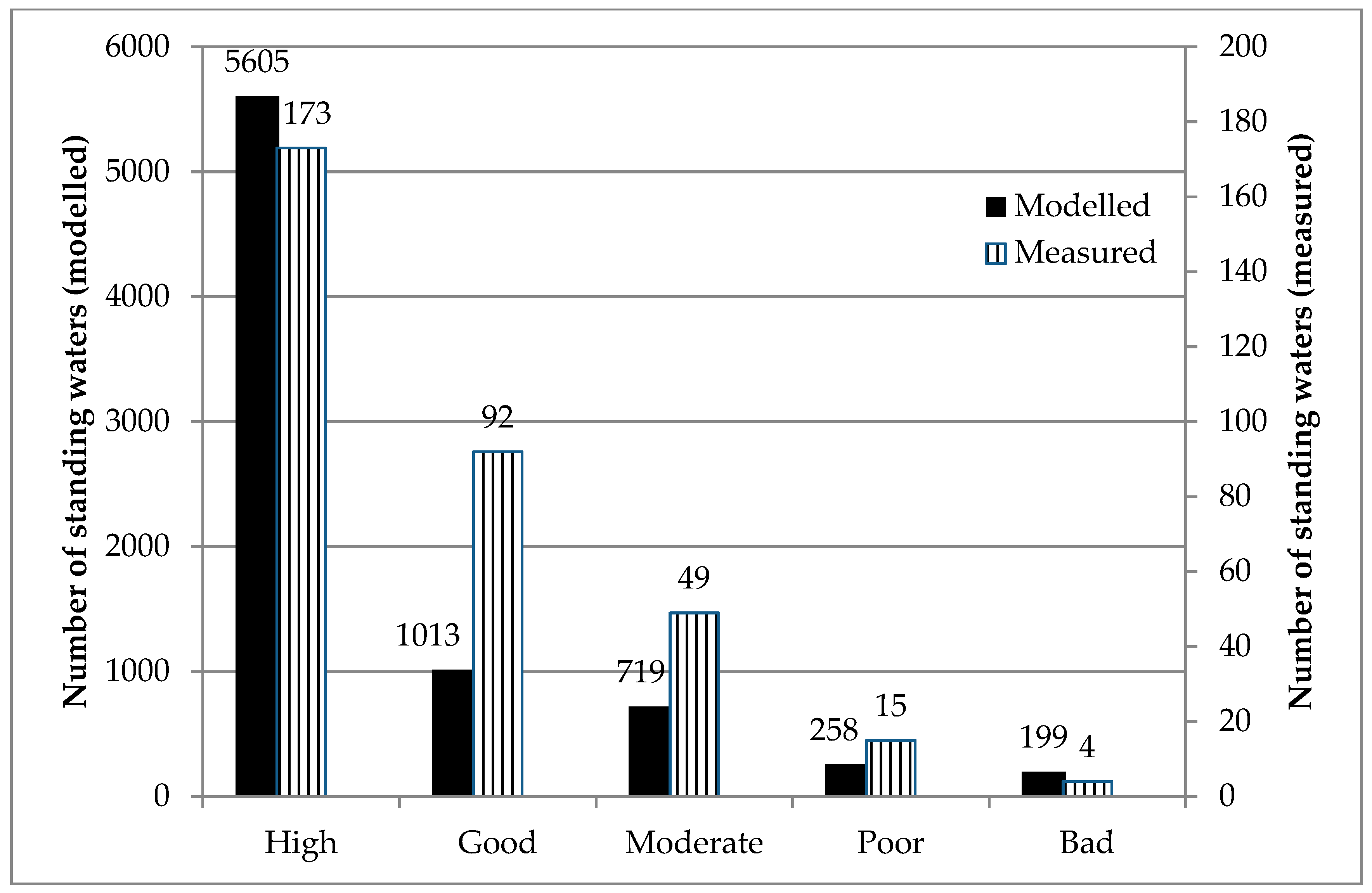

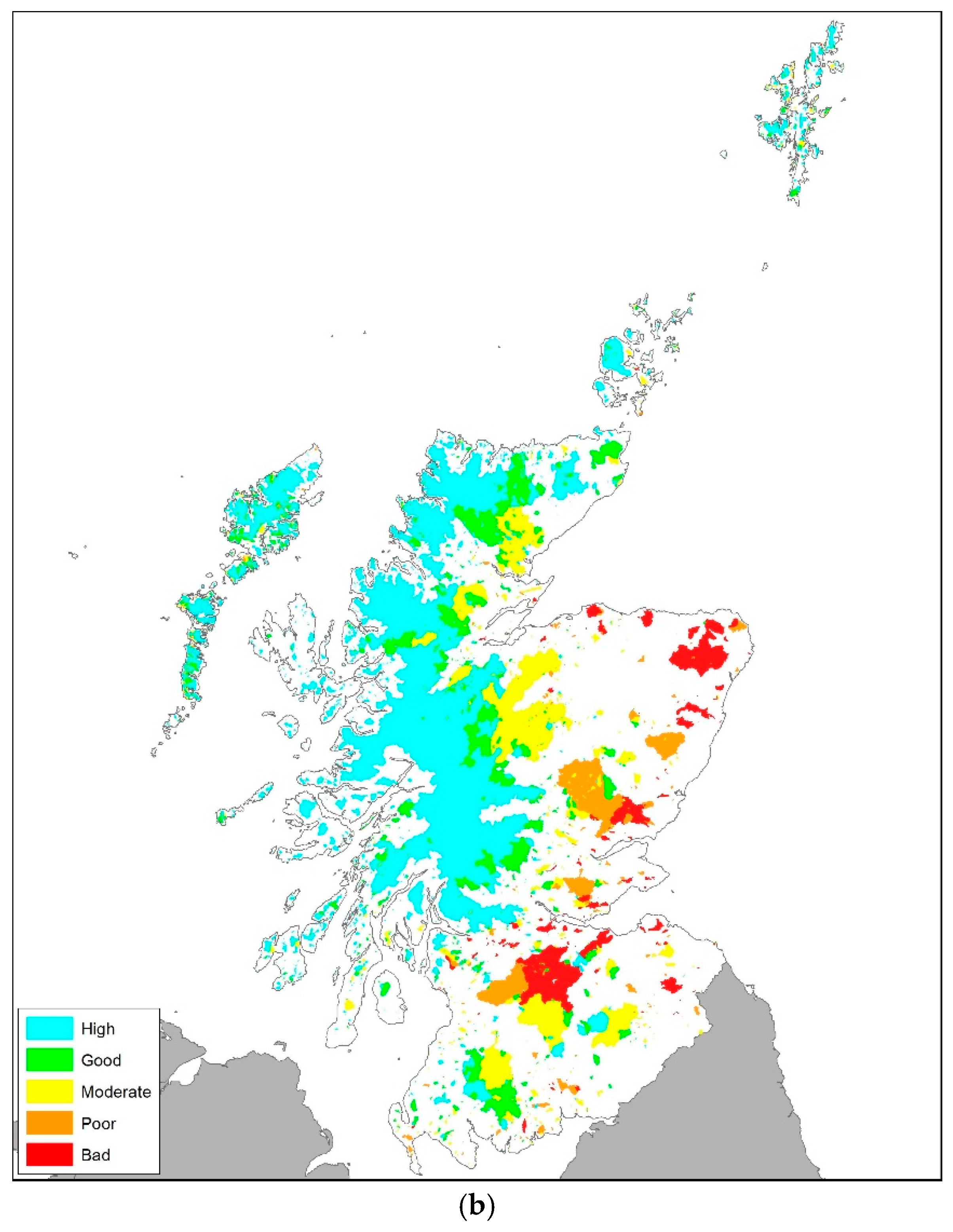
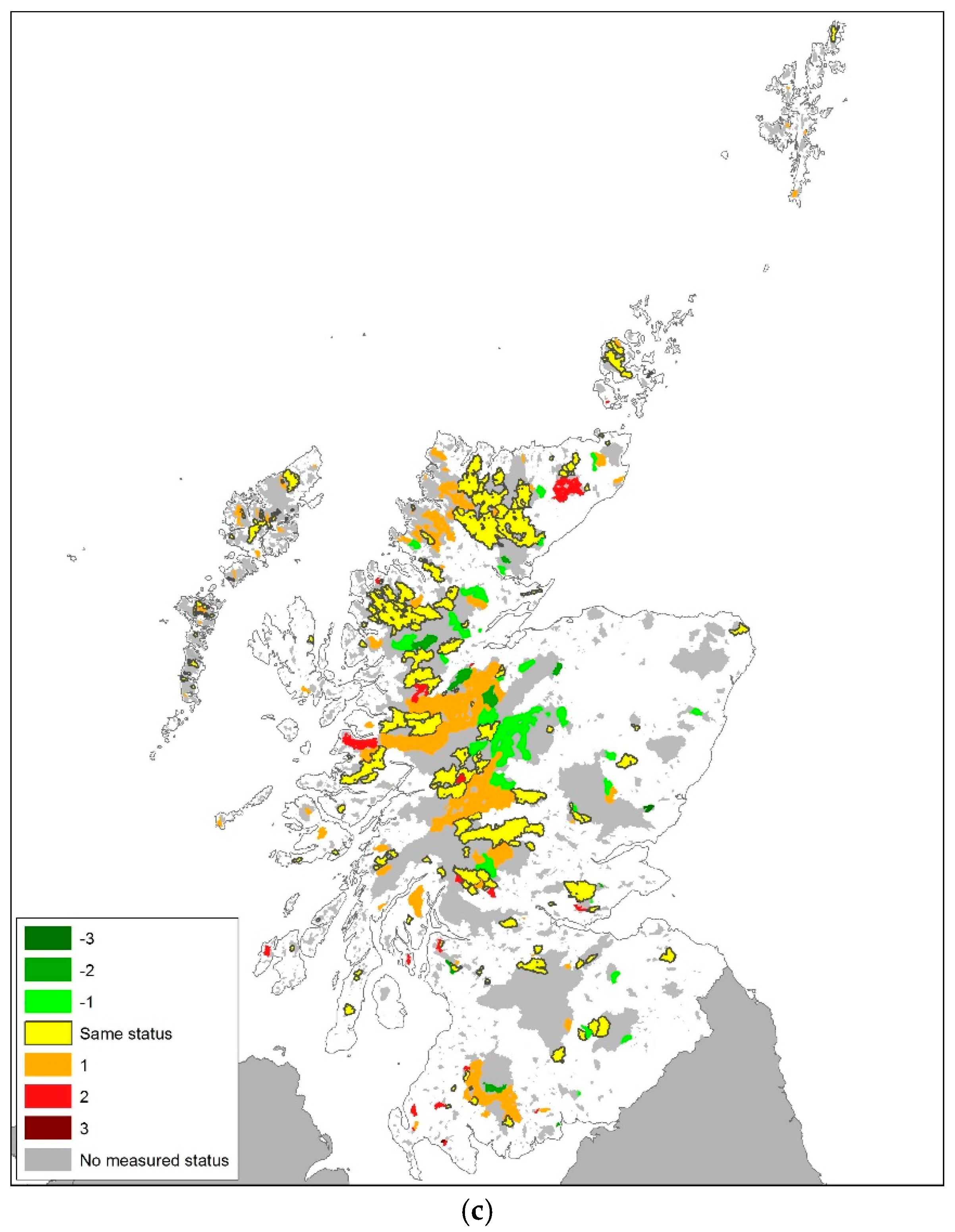
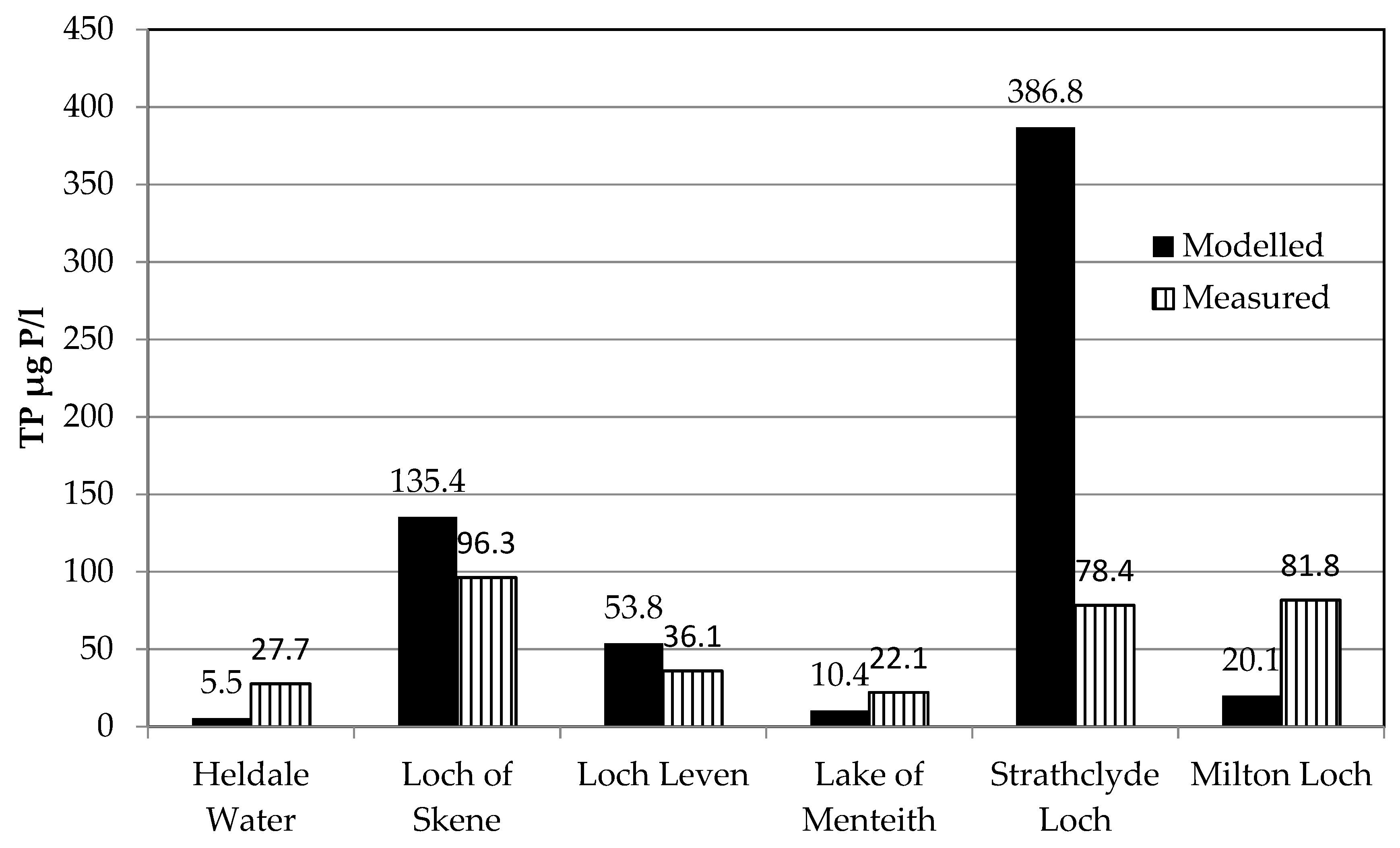
| Land Cover Category | Slope Threshold | ||
|---|---|---|---|
| Low 0–4 Degrees | Medium 4–13 Degrees | High 13+ Degrees | |
| Water | 0.135 | ||
| Wetland | 0.085 | ||
| Blanket bog & peatland | 0.020 | 0.030 | 0.040 |
| Arable | 0.740 | 1.140 | 1.540 |
| Improved grassland | 0.320 | 0.470 | 0.620 |
| Coarse grassland, Smooth grassland, Heather all types, Bracken | 0.060 | 0.090 | 0.115 |
| Cliffs | 0.045 | ||
| Montane vegetation | 0.025 | 0.040 | 0.060 |
| Low scrub | 0.140 | 0.190 | 0.240 |
| Broadleaved woodland | 0.150 | 0.215 | 0.275 |
| Mixed woodland, Open canopy young plantation | 0.125 | 0.175 | 0.235 |
| Coniferous plantation | 0.100 | 0.145 | 0.195 |
| Recently ploughed land | 0.560 | 0.760 | 0.960 |
| Woodland recently felled | 0.360 | 0.560 | 0.760 |
| Ripping | 0.300 | 0.365 | 0.425 |
| Estuary, Salt marsh, Dune land, Maritime grasslands & heaths | 0.000 | 0.000 | 0.000 |
| Airfields, Recreational land, Quarries, Other land, Road & rail | 0.000 | 0.000 | 0.000 |
| Factories & urban | 1.380 | 2.105 | 2.830 |
| Results for Measured Catchments | P Concentration (µg/l), n = 323 | ||
|---|---|---|---|
| Minimum | Median | Maximum | |
| Lowest TP | 1.5 | 2.1 | 2.6 |
| Mean TP | 10.3 | 12.6 | 14.8 |
| Highest TP | 459.4 | 473.4 | 487.3 |
| Comparison to median export coefficient (model default) | |||
| Lowest TP | 71.4% | - | 123.8% |
| Mean TP | 81.5% | - | 117.4% |
| Highest TP | 97.0% | - | 102.9% |
| Baseline | Land Cover | Discharge (Using 2015 Land Cover) | |||||
|---|---|---|---|---|---|---|---|
| 1988 | 2015 | Minus 10% | Minus 5% | Plus 5% | Plus 10% | ||
| Minimum | 0 | 0 | 0 | 0 | 0 | 0 | 0 |
| 5th percentile | 3.1 | 2.4 | 3.1 | 3.2 | 3.1 | 3 | 2.9 |
| 10th percentile | 3.5 | 2.9 | 3.5 | 3.8 | 3.7 | 3.4 | 3.3 |
| median | 5.6 | 4.9 | 5.6 | 6 | 5.8 | 5.5 | 5.3 |
| Mean | 18.1 | 17.6 | 18.1 | 19.4 | 18.8 | 17.6 | 17 |
| 90th percentile | 19.7 | 19.5 | 19.7 | 21.1 | 20.4 | 19.1 | 18.5 |
| 95th percentile | 35.2 | 36.8 | 35.2 | 37.9 | 36.5 | 34 | 32.8 |
| Maximum | 3467 | 3468.9 | 3467 | 3722.5 | 3589.3 | 3354.1 | 3249.6 |
| Standard Deviation | 104.99 | 105.33 | 104.99 | 112.80 | 108.72 | 101.55 | 98.38 |
| Standard Error | 1.172 | 1.175 | 1.172 | 1.259 | 1.213 | 1.133 | 1.098 |
| Measured | High | 7 (2.2%) | 19 (5.9%) | 146 (45.2%) | ||
| Good | 13 (4.0%) | 21 (6.5%) | 53 (16.4%) | |||
| Moderate | 1 (0.3%) | 2 (0.6%) | 6 (1.9%) | 14 (4.3%) | 22 (6.8%) | |
| Poor | 3 (0.9%) | 1 (0.3%) | 2 (0.6%) | 5 (1.5%) | 4 (1.2%) | |
| Bad | 1 (0.3%) | 2 (0.6%) | 1 (0.3%) | |||
| Bad | Poor | Moderate | Good | High | ||
| Modelled |
| Source | Load Min. | Load Max. | Load Median |
|---|---|---|---|
| Land cover | 343 | 665 | 504 |
| Fish farm | 14 | 30 | 22 |
| Fish cages | 85 | 105 | 95 |
| Hotel 1 | 3 | 13 | 8 |
| Septic tanks | 40 | 80 | 60 |
| Birds | 25 | 95 | 60 |
| Rain | 25 | 75 | 50 |
| Sum | 535 | 1063 | 799 |
© 2020 by the authors. Licensee MDPI, Basel, Switzerland. This article is an open access article distributed under the terms and conditions of the Creative Commons Attribution (CC BY) license (http://creativecommons.org/licenses/by/4.0/).
Share and Cite
Donnelly, D.; Helliwell, R.C.; May, L.; McCreadie, B. An Assessment of the Performance of the PLUS+ Tool in Supporting the Evaluation of Water Framework Directive Compliance in Scottish Standing Waters. Int. J. Environ. Res. Public Health 2020, 17, 391. https://doi.org/10.3390/ijerph17020391
Donnelly D, Helliwell RC, May L, McCreadie B. An Assessment of the Performance of the PLUS+ Tool in Supporting the Evaluation of Water Framework Directive Compliance in Scottish Standing Waters. International Journal of Environmental Research and Public Health. 2020; 17(2):391. https://doi.org/10.3390/ijerph17020391
Chicago/Turabian StyleDonnelly, David, Rachel C. Helliwell, Linda May, and Brian McCreadie. 2020. "An Assessment of the Performance of the PLUS+ Tool in Supporting the Evaluation of Water Framework Directive Compliance in Scottish Standing Waters" International Journal of Environmental Research and Public Health 17, no. 2: 391. https://doi.org/10.3390/ijerph17020391
APA StyleDonnelly, D., Helliwell, R. C., May, L., & McCreadie, B. (2020). An Assessment of the Performance of the PLUS+ Tool in Supporting the Evaluation of Water Framework Directive Compliance in Scottish Standing Waters. International Journal of Environmental Research and Public Health, 17(2), 391. https://doi.org/10.3390/ijerph17020391





